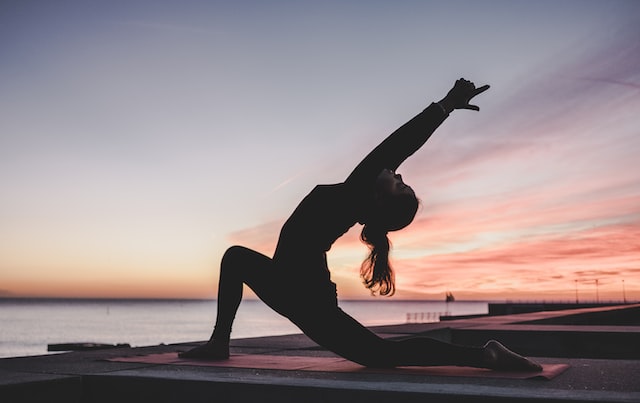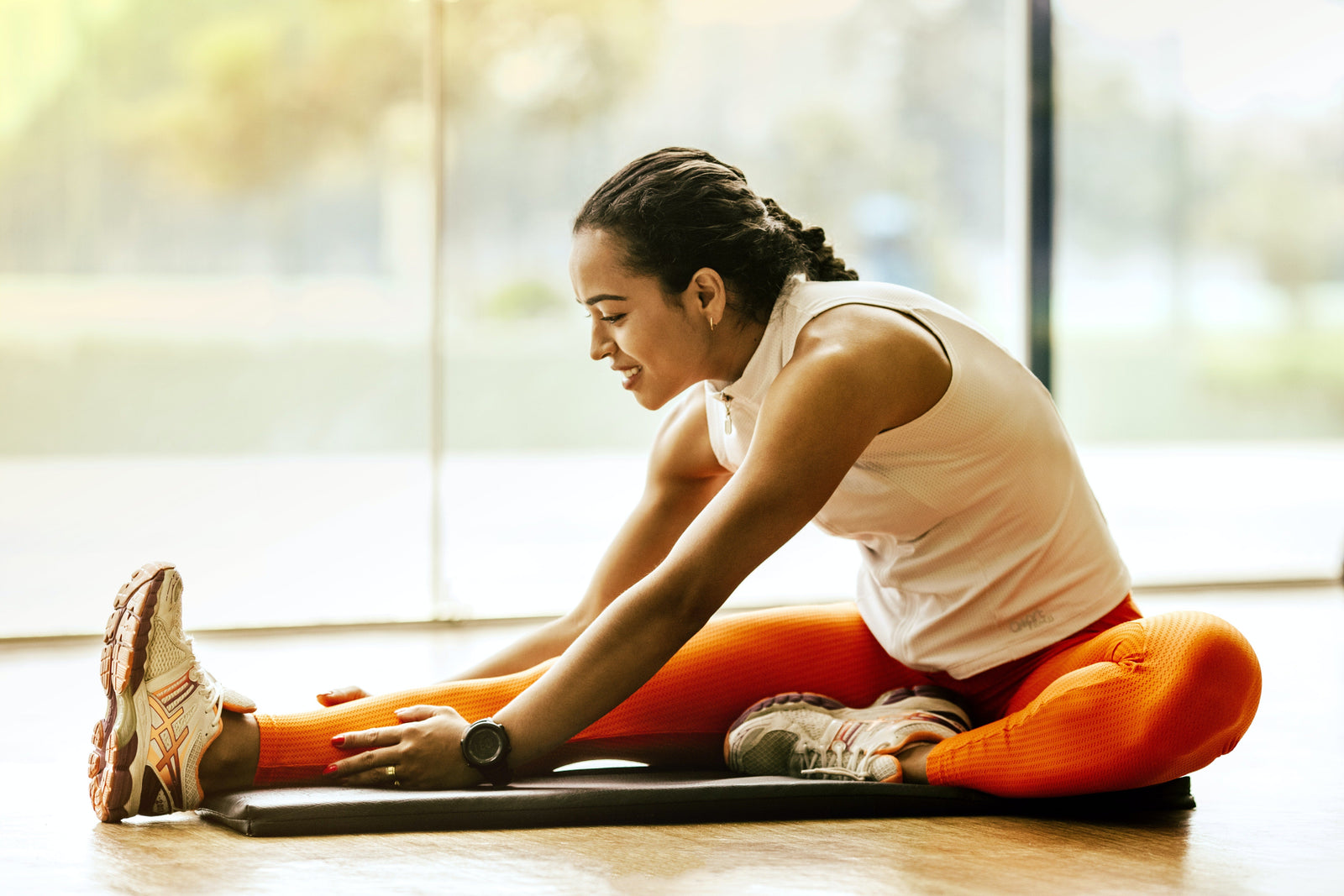There’s no feeling like a good stretch before bed. Stretching is a quick practice that anyone can do anywhere… and the benefits “stretch” across many aspects of life (pun intended)!
A 2016 review of studies cites a link between meditative movements such as yoga or stretching and enhanced sleep quality.
Moreover, if you have a sleep disorder, stretching can help you keep a handle on symptoms.
Yoga for sleep apnea exists – and it’s thought to tone the open upper airway muscles for boosted airway health.
Our quality of sleep is directly tied to our quality of life, and stretching is a simple, free tool that anyone can take advantage of.
That’s why we’ve rounded up five stretches to try before bed for your best sleep yet.
But before we embark on our journey toward each stretch, there’s more to uncover about what you have to gain from nightly stretching.
The advantages of stretching before bed far outweigh better sleep! By simply stretching each day we can relieve stress, prevent injury, and more.
Stretch Your Way to Wellness
Stretching is a secret weapon for better sleep, largely because of the additional perks it provides the body and mind.
The act of stretching is proven to improve blood flow by boosting circulation to muscles and joints, helping to deliver more oxygen to these areas.
In turn, it’s thought that leg stretches may even help protect the body against conditions associated with reduced blood flow such as heart disease, stroke, or diabetes.

As a result, stretching helps to relieve tense muscles. The phrase, “use it or lose it” is a truthful one, as large periods of inactivity cause a build-up of tension in the muscles.
That means more all-around discomfort, especially when you’re trying to sleep. Stretching provides relief from muscle tension by extending the length of each muscle.
The greater a muscle’s length extends, the less tension it holds. This doesn’t just decrease discomfort, it prevents the risk of injury and lowered mobility caused by stiff muscles.
Furthermore, stretching places the body and mind in a relaxed state, bringing stress levels down.
Around 77 percent of people say that stress impacts their physical health, while 73 percent blame stress for negatively impacting their mental health.
Moreover, 48 percent of people report problems with sleeping due to stress.
It’s no surprise that stress levels have skyrocketed due to the stresses of modern life that leave many of us stuck in a stressed state of “fight or flight.”
As stress becomes a chronic problem across the globe, stretching offers a meditative practice that activates our parasympathetic nervous system, taking us out of fight or flight and preparing us for rest and relaxation.
@somnifix WHY is #stretching before bed good? 🙆 #bedtimeroutine #bedtimeyoga #circulation #strokeprevention #didyouknowfacts #learnontiktok ♬ Bikini Bottom - Ice Spice
By focusing on the body, we can get out of the mind and ground ourselves with simple movements.
If you want to experience all of the benefits associated with stretching (including better sleep) but aren’t sure where to start, child’s pose offers a gentle ease into a nightly stretching routine.
#1: Child’s Pose
Child’s pose, one of the most frequently practiced yoga poses, offers a gentle stretch while you rest and turn your attention toward your breathing patterns.
This pose derived its name from its close resemblance to a child resting in the fetal position. It’s known to relieve tension in the back, shoulders, neck, and hips.
To practice this grounding pose, come down on your knees and sit back on your heels. Fold forward and rest your head on the floor, if possible.
Finally, extend your arms forward to provide support to your neck or leave them at the sides of your body. Place a pillow under your thighs or forehead for added support, if needed.
Hold the pose for around five minutes, breathing deeply and focusing on the pattern of your breath. Notice any discomfort or tightness across the body.
Once you’ve mastered this pose, turn toward a stretch named after a master of stretching in the animal kingdom: the cat!
#2: Cat-Cow
Do you spend most of the day sitting or standing? This stretch helps to improve posture and balance by strengthening and stretching the neck and spine.
If you’re interested in practicing yoga for sleep apnea, the deep neck stretch this pose provides may help to open up and tone your upper airway muscles and tissues.
Moreover, the cat-cow pose stretches the hips and abdomen, helping to stimulate internal organs in the stomach including the kidneys and adrenal glands.
This stretch may also increase coordination and balance in just minutes per day.
To practice cat-cow, get on your hands and knees. Be sure to place your hands underneath your shoulders with your knees placed under the hips.
From here, arch your back and tighten the abdominal muscles, tucking in the tailbone. This is known as the “cat” position of cat-cow. Hold this pose for at least ten seconds.
Next, allow your lower back to relax toward the floor, rotating your tailbone upward with your neck stretched toward the sky. This is the “cow” position. Hold this pose for ten seconds.
Finally, return to the neutral starting position and repeat this process five to ten times.
Next, take things to a relaxed, seated position with seated spinal twists.
#3: Seated Spinal Twists
Looking for a restorative stretch that also helps to promote digestion? Look no further than seated spinal twists.
Twisting helps to massage internal organs, relieve lower back pain, and even encourages spinal mobility.
A seated spinal twist combines deep breathing methods with gentle twists that help stretch the stress out of your spine.
What’s more, you can perform these before bed or even in the middle of the day at your desk for a quick breather that adds some pep to your step.
To practice a seated spinal twist, scoot toward the edge of your chair or bed with your feet flat on the floor.
Place your right hand at the back of your seat or behind you with your left hand on your right thigh.
Inhale and lengthen the spine. From here, exhale and rotate your torso to the right, gently looking over the right shoulder.
Hold this pose for anywhere from 30 seconds up to one minute. Switch to the left side and repeat.
If you’re looking for relaxing poses, our last two moves are sure to provide a soothing stretch. This next pose may even make you feel as happy as a sleepy baby!
#4: Happy Baby
The happy baby pose gets its name from its resemblance to a baby lying happily on its back.
Happy baby helps to relax the spine, arms, and lower body by opening up the inner thighs, hips, and groin while realigning the spine.
You may also feel a stretch in your hamstrings while practicing this relaxing pose.
To begin, lie on your back either on the floor or on your bed. Lift your legs and bend your knees, grabbing the toes on each of your feet.
Hold this pose for around four minutes, staying in this position as you stretch through and lengthen your body.
For an even more deeply soothing stretch, move on to the “Legs Up the Wall” pose.
#5: Legs Up the Wall
Legs up the wall offers multiple benefits for not just your body, but your mind.
This stretch gives you time to take note of your breathing and check in with each part of your body, noticing any sore or tired muscles.
While in this pose, the nervous system can rest as the blood flows in the opposite direction due to the positioning of the legs at a higher point than the rest of the body.
This pose also takes pressure off of the back, helping to relieve lower back pain and tension while opening up the hips.
It's also believed to reduce knee pain, relieve neck tension, and relieve leg and foot cramps.
There are even claims that this pose can help relieve headaches, improve digestion, reduce high blood pressure, and calm restless leg syndrome.
When performing legs up the wall, avoid placing your body too far up against the wall, as this puts unnecessary pressure on the hamstrings and hips.
@somnifix Try this trick for improved #sleep tonight! 🛏 #legsupthewall #insomnia #yogaflow #nightroutine #wellness #DidYouKnow ♬ Play Date - Melanie Martinez
Place a cushion under your bottom for added comfort and scoot away from the wall to avoid forming a precise 90-degree angle.
To perform this stretch, find a wall and place your cushion or pillow against it. Scoot your hips toward the wall, moving your feet up until your body nearly makes an “L” shape.
Rest your arms along your sides or on your chest. Focus on breathing slowly in and out of your nose while stretching your legs and calming your mind.
Stay in this pose for a comfortable few minutes, building up to anywhere from 10 to 15 minutes total over time.
If you find it hard to practice controlled, slow nasal breathing as you practice these stretches, your airway health may need some attention.
Most people who find it hard to nasal breathe during the day find it even harder to nasal breathe at night. As a result, their risk of snoring and developing sleep apnea skyrockets.
Talk about a nightmare!
Stretch Your Airway: Nasal Breathing 101
Even if you stretch your way to a relaxed state for improved sleep or you practice yoga for sleep apnea every day, your health may still be at risk if you aren’t nasal breathing the majority of the time.
Our noses were made for breathing and smelling, while our mouths are for eating. If you’re habitually mouth breathing, your risk for snoring and sleep apnea is elevated, putting your overall health at risk.
Remember the phrase “use it or lose it?” If you don’t use your nose to breathe, it becomes harder to regain control of your airway health.

The more you mouth breathe, the more congested you become. In turn, nasal breathing is harder than ever before. To break the cycle, you have to train yourself to nasal breathe.
What’s the big deal, anyway? Mouth breathing causes airway tissues to fall backward during sleep, leading to snoring and sleep disorders over time.
Moreover, the nose filters and humidifies the air, injecting our bodies with a natural production of nitric oxide, a miracle molecule that works as a vasodilator to improve oxygenation.
Mouth breathing leaves the air unfiltered and de-humidified, allowing for harmful pathogens and bacteria to enter the body, wreaking havoc on the immune system.
There’s just one problem…how do you nasal breathe while you’re asleep? By preventing the mouth from falling open at night, you can ensure that you’ll nasal breathe all night long.
Mouth tape offers a gentle, effective lip seal that promotes nasal breathing, prevents snoring, and improves sleep.

SomniFix offers Mouth Strips with a gentle, gel-like adhesive free from irritants known to cause rashes and irritation.
Our Mouth Strips also offer a patented breathing vent that offers emergency mouth breathing if you happen to become congested overnight.
Stretch out your lungs and airway for your best sleep yet by nasal breathing into the night with SomniFix!







